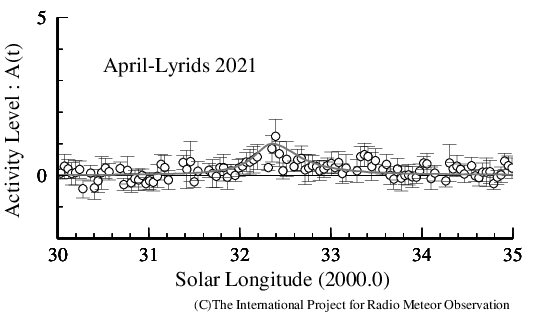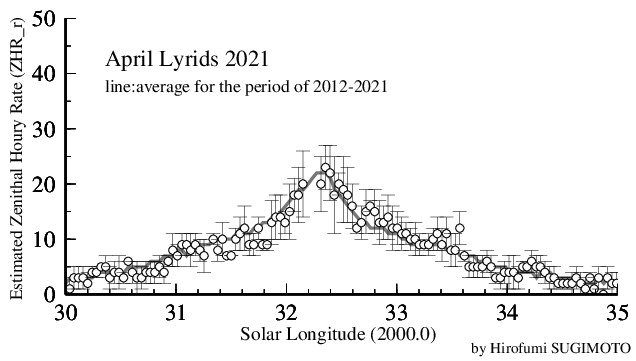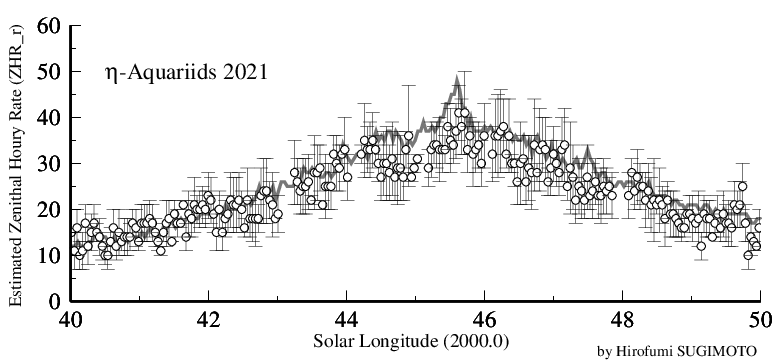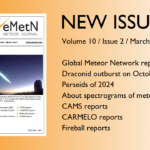By Hiroshi Ogawa and Hirofumi Sugimoto
Abstract: Worldwide Radio Meteor Observations recorded the meteor showers of the April–Lyrids and η-Aquariids 2021. The April-Lyrids showed the same activity level as usual in ordinary years. The peak time occurred at λʘ = 32.35° (April 22nd 13h UT). The ZHRr was estimated to be around 23 ± 4. On the other hand, η-Aquariid activity was weaker than usually in other years. The peak occurred in the time lapse of λʘ = 45.1° to 45.8° (May 5th17h – 6th 9h UT). The ZHRr was estimated to be around 35–40.
1. Introduction
Worldwide radio meteor observation data were provided by the Radio Meteor Observation Bulletin (RMOB) (Steyaert, 1993) and by the radio meteor observation network in Japan (Ogawa et al., 2001). Radio meteor observations are possible even with bad weather and during daytime.
2. Method
For analyzing the worldwide radio meteor observation data, the meteor activity is calculated by the “Activity Level: A(t)” index (Ogawa et al., 2001). The activity profile was estimated by the Lorentz activity profile (Jenniskens et al., 2000). Besides of this analysis, also the Zenithal Hourly Rates were estimated (Sugimoto, 2017).
3. Results
3.1. April-Lyrids
Figure 1 shows the result of the April-Lyrids based on the calculation of the Activity Level Index A(t). The solid line shows the average for the period 2007–2020. Some high activity was seen around λʘ = 32.2°–32.6°. The maximum activity level was observed with values of 1.3 ± 0.5 at λʘ = 32.39° (April 22, 14h UT). The peak time using the Lorentz profile was estimated at April 22nd 13h with Amax = 1.0, FWHM = –6.0hr / +9.0hr. This activity level is the same as the annual level.

Figure 1 – The Activity Level Index by radio meteor observations from all over the world (the line is the average obtained for the period of 2007–2020).
ZHRr is shown in Figure 2 (calculated by Sugimoto). The April-Lyrids 2021 show the same activity as the average annual activity, just like the Activity Level index. The solid line shows the average for the period 2012–2021. The maximum ZHRr was estimated to be 23 ± 4 at λʘ = 32.35° (April 22, 13h UT).

Figure 2 – The estimated ZHR by radio meteor observations from all over the world (the line is the average obtained for the period of 2012–2021).
3.2. Eta Aquariids
Figure 3 shows the result for the η-Aquariids 2021 based on the calculations with the Activity Level Index. The line represents the average for the period of 2004–2020. The maximum was estimated Amax = 0.7 at around λʘ = 45.15° (May 5, 17h UT). In 2021 the η-Aquariid meteor shower displayed a weaker activity level than in normal years (annual Amax = 1.0). The number of long meteor echoes of more than 20 seconds was also poor as recorded by the Japanese radio meteor observers.

Figure 3 – The Activity Level Index by radio meteor observations from all over the world (the line is the average obtained for the period of 2004–2020).
ZHRr is displayed in Figure 4 (calculated by Sugimoto). The average for the period 2012–2021 (solid line) shows a maximum ZHRr around 50. In 2021, however, the maximum ZHRr was estimated to be around 35–40 at λʘ = 45.4° – 45.9° (May 5, 23h – May 6, 9h UT).

Figure 4 – The estimated ZHR by radio meteor observations from all over the world (the line is the average obtained for the period of 2012–2021).
Acknowledgment
The April-Lyrids and η-Aquariids 2021 data were provided by the following observers:
Chris Steyaert (Belgium), Johan Coussens (Belgium), Halei BI7NTP (China), DDMTREBIC-R3 (Czech Republic), DanielD SAT01_DD (France), Jean Marie F5CMQ (France), Pierre Micaletti (France), WHS Essen (Germany), Balogh Laszlo (Hungary), AAV Planetario_di_Venezia (Italy), Associazione Pontina di Astronomia _APA_ (Italy), Fabio Moschini_IN3GOO (Italy), GAML Osservatorio_Astronomico_Gorga (Italy), Mario Bombardini (Italy), Hirofumi Sugimoto (Japan), Hironobu Shida (Japan), Hiroshi Ogawa (Japan), Hirotaka Otsuka (Japan), Kenji Fujito (Japan), Masaki Kano (Japan), Masaki Tsuboi (Japan), Nobuo Katsura (Japan), Tomohiro Nakamura (Japan), Rainer Ehlert (Mexico), Salvador Aguirre (Mexico), Kees Meteor (Netherlands), Rafael Martinez (Puerto Rico), Karlovsky Hlohovec_Observatory (Slovakia), Jose Carballada (Spain), RondaRonda (Spain), Jochen Richert (Switzerland), Ian Evans (UK), John Berman (UK), John Collins (UK), Philip Norton (UK), Simon Holbeche (UK), Eric Smestad_KC0RDD (USA), Mike Otte (USA) and Stan Nelson (USA).
The worldwide data were provided by the Radio Meteor Observation Bulletin (RMOB) (http://www.rmob.org/).
References
Jenniskens P., Crawford C., Butow S. J., Nugent D., Koop M., Holman D., Houston J., Jobse K., Kronk G., and Beatty K. (2000). “Lorentz shaped comet dust trail cross section from new hybrid visual and video meteor counting technique imprications for future Leonid storm encounters”. Earth, Moon and Planets, 82–83, 191–208.
Ogawa H., Toyomasu S., Ohnishi K., and Maegawa K. (2001). “The Global Monitor of Meteor Streams by Radio Meteor Observation all over the world”. In, Warmbein Barbara, editor, Proceeding of the Meteoroids 2001 Conference, 6-10 August 2001, Swedish Institute of Space Physics, Kiruna, Sweden. ESA Publications Division, European Space Agency, Noordwijk, The Netherlands, pages 189–191.
Ogawa H. and Steyaert C. (2017). “Major and Daytime Meteor Showers using Global Radio Meteor Observations covering the period 2001–2016”. WGN, Journal of the International Meteor Organization,45, 98–106.
Rendtel J. (2020). 2021 Meteor Shower Calendar. International Meteor Organization.
Sugimoto H. (2017). “The New Method of Estimating ZHR using Radio Meteor Observations”. eMetN, 2, 109–110.


